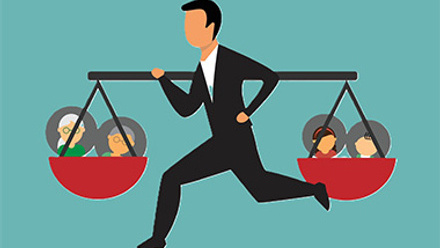Four steps to getting employees back to work after burnout
Burnout is a business issue. Classified as an ‘occupational phenomenon’ by the World Health Organisation in 2019, burnout is a state of physical and emotional exhaustion.
Brought about by long-term stress at work, or when an employee has been working in a physically or emotionally draining role for a long time, burnout symptoms include feeling tired or drained most of the time, feeling trapped or detached, having a cynical or negative outlook and feeling overwhelmed.
And employee burnout is a global concern. In a survey of more than 1,000 US respondents by Deloitte, 77% say they have experienced burnout at their current job. And 91% say that unmanageable stress or frustration impacts the quality of their work, while 83% say burnout can affect personal relationships.
For some, burnout can also result in sickness absence, and this is where your Group Income Protection (GIP) provider can step in, to help get that person back into work — and help them stay there. As part of a GIP offering, your provider’s vocational rehabilitation consultants could provide the following services to help support an employee back to work:
1. Employee assessment
In cases where an employee is absent, rehabilitation consultants can examine their situation and explore any barriers to their return to work. Then it’s a case of discussing how to break down those barriers. This could include teaching them how to build up energy and arming them with coping mechanisms to deal with the symptoms of burnout. This includes include rest, mindfulness, meditation, breath work and sleep prioritisation.
2. Working with employers
As well as talking to the employee, it’s important to establish a clear dialogue with their line manager, to identify the reasons behind the employee’s absence. These discussions should focus on reviewing the employee’s job role, their workload and workplace relationships.
3. Producing a plan
It’s key not to overwhelm someone suffering from burnout. Their return to work must include a plan that focuses on small steps and marginal gains and reviewing all aspects of wellbeing as you go.
4. Identifying reasonable adjustments
A smooth transition back to work requires adjustments on both sides. Employees might need support in setting boundaries and learning to say ‘no’. Employers should be prepared to reduce the individual’s workload and help ensure they take regular breaks. Rehab consultants ensure employees are able to prioritise what’s important, at work and at home.
Prevention is better than cure
Recognising and understanding how to tackle burnout is something all companies, big or small, need to prepare for, but in an ideal world employees would never hit burnout. By the time someone is so stressed that burnout causes sickness absence, the cost to them is already too high.
That’s why it’s important to know what the causes of stress are, enabling you to act on them early. According to the Health and Safety Executive, the top causes of stress at work are:
- Being unable to cope with the demands of your job
- Lack of control over how to do your work
- Lack of information and support
- Difficulties with relationships at work, including bullying
- Not fully understanding your role and responsibilities
- Feeling disengaged as the business goes through change.
It’s here an offering such as Unum’s Wellbeing Check could prove invaluable. This provides a 1-2-1 coaching session with an employee struggling with their wellbeing, whether the issue is personal or work-related.
Resilience is how we withstand, bounce back and grow, whatever life throws at us and building resilience plays a big part in preventing burnout. The Robertson Cooper personality questionnaire is a useful tool to help individuals increase their resilience. It reveals which of four key components you naturally draw on for resilience — confidence, adaptability, purposefulness and the need for social support — and explains ways to build on existing areas of strength and how to manage areas of potential risk.
Burnout is a modern phenomenon that’s reflective of our high-paced, multi-faceted working lives. If employers are educated in its causes and symptoms, they can do their best to prevent stress-related sickness absence. And if the worst does come to the worst, you can work together with your GIP provider to get employees back to their jobs safely and sustainably.
Supplied by REBA Associate Member, Unum
Helping the working world thrive throughout life’s moments’








